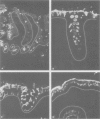Abstract
The intestinal expression pattern and general tissue distribution of the M(r) 40 kD putative epithelial autoantigen in ulcerative colitis were re-examined by in situ two and three colour immunofluorescence staining including the murine monoclonal antibody 7E12H12. The intestinal distribution was also compared with the epithelial codeposition of IgG1 and activated complement (C3b and terminal complement complex) seen selectively in ulcerative colitis. The M(r) 40 kD antigen was found for the first time in goblet cells of normal terminal ileum and proximal colon but not in rectal goblet cells. By contrast, colonic enterocytes expressed this antigen apically with increasing intensity in a distal direction, expanding to intense cytoplasmic expression in rectal enterocytes. The antigen was also expressed by the epithelium of the fallopian tubes, major bile ducts, gall bladder, and epidermis but not by proximal gastrointestinal tract epithelium or 13 other extra-gastrointestinal organs. Activated complement and IgG1 often colocalised with the M, 40 kD antigen apically on the surface epithelium in active ulcerative colitis but not in Crohn's disease. Our results support the idea that an autoimmune response to this antigen, leading to complement activation mediated by IgG1, is a possible pathogenetic mechanism for epithelial damage and persistent inflammation in ulcerative colitis.
Full text
PDF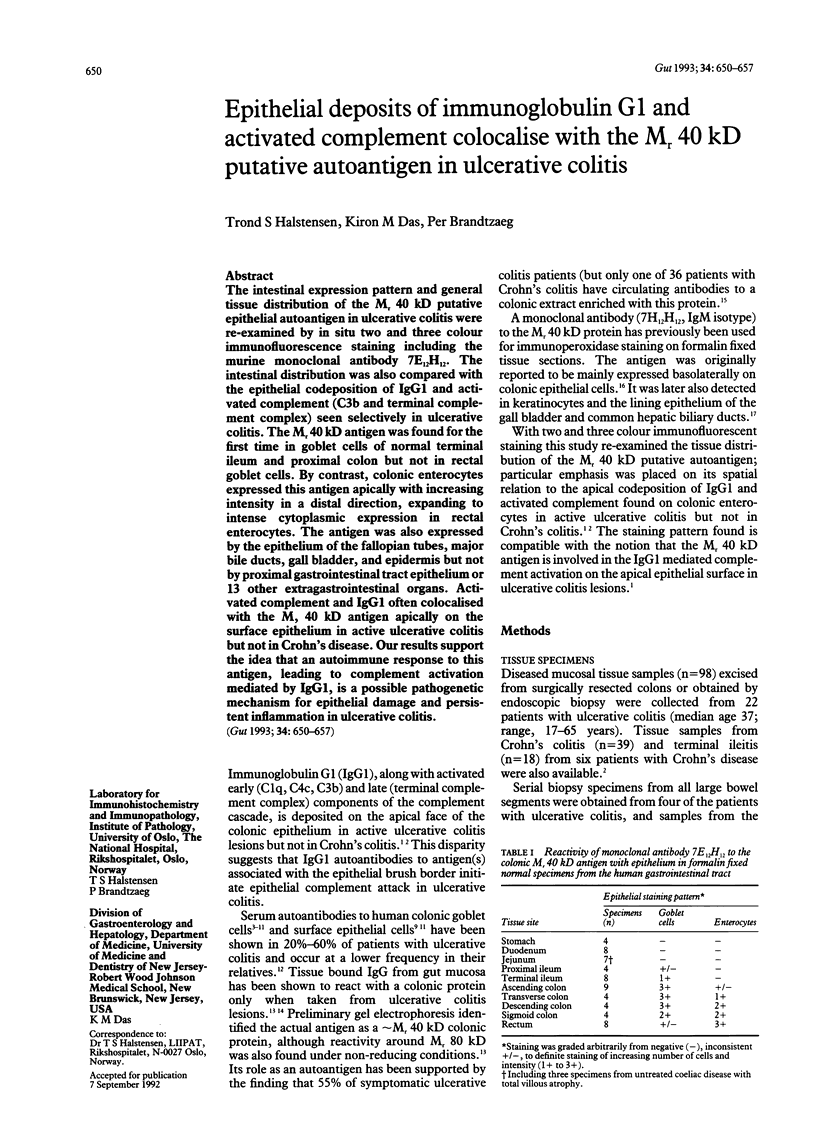
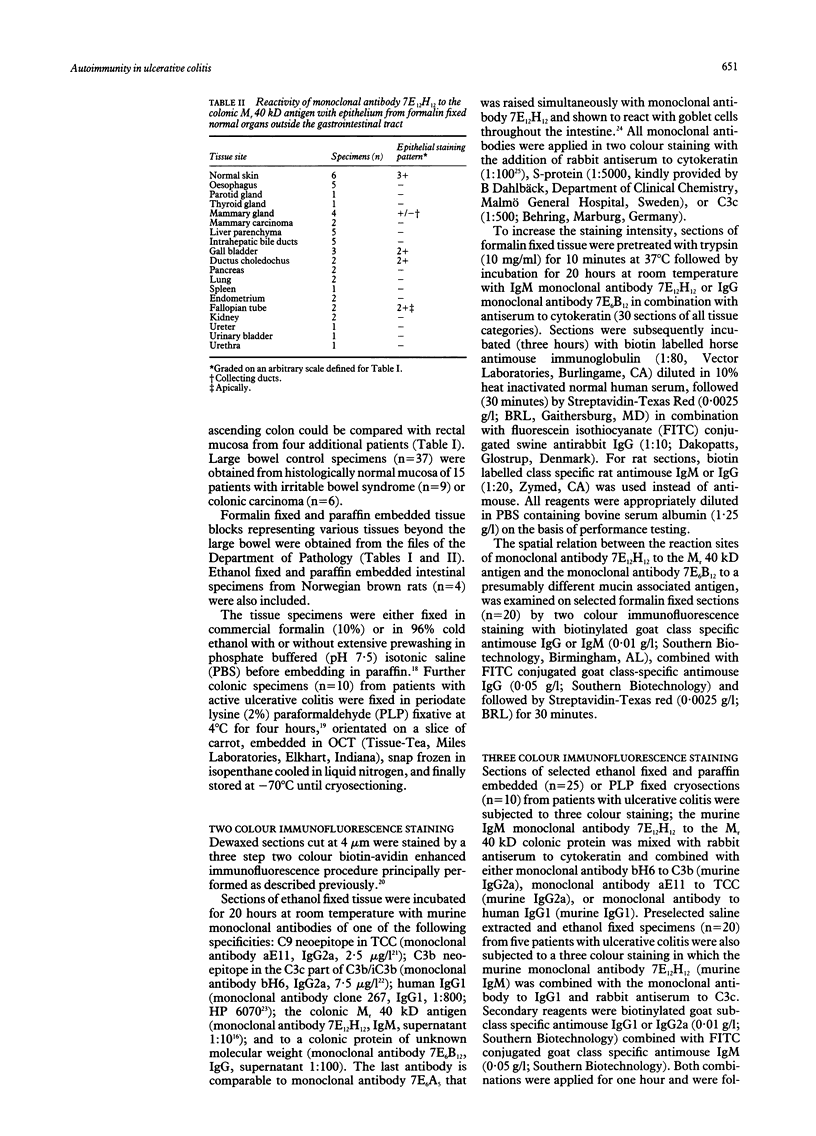
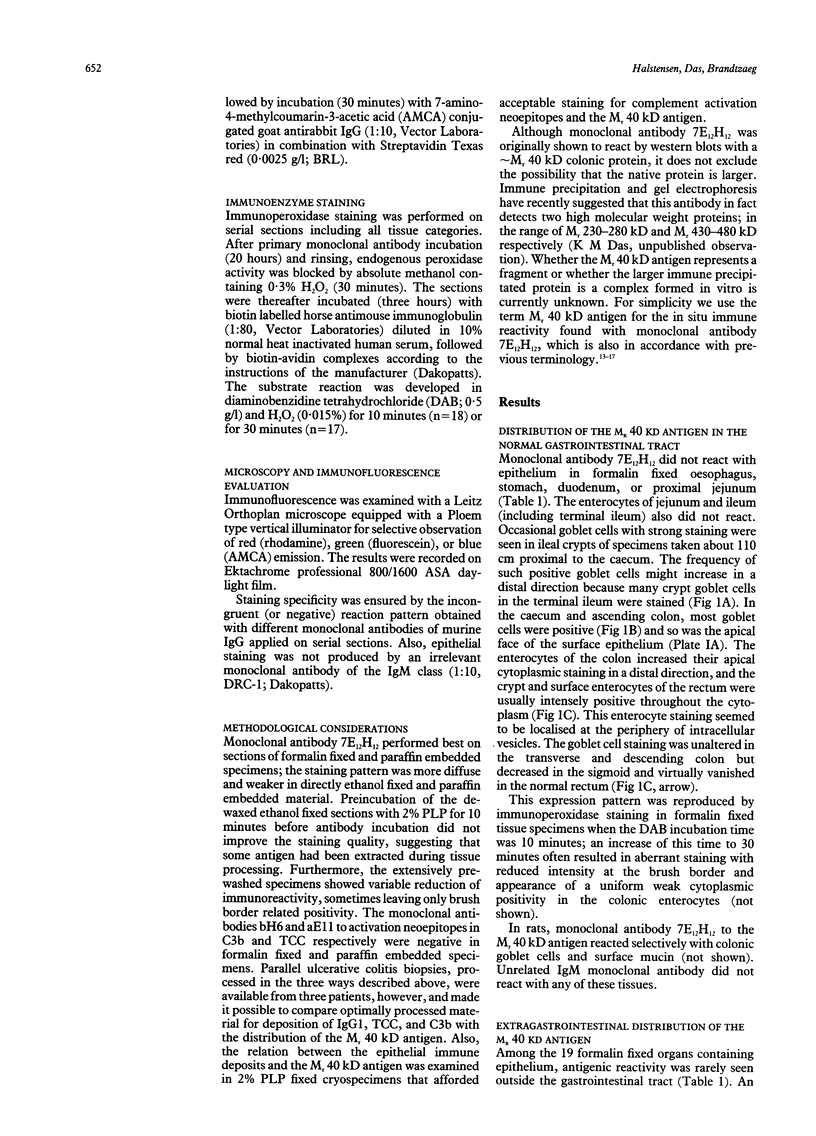
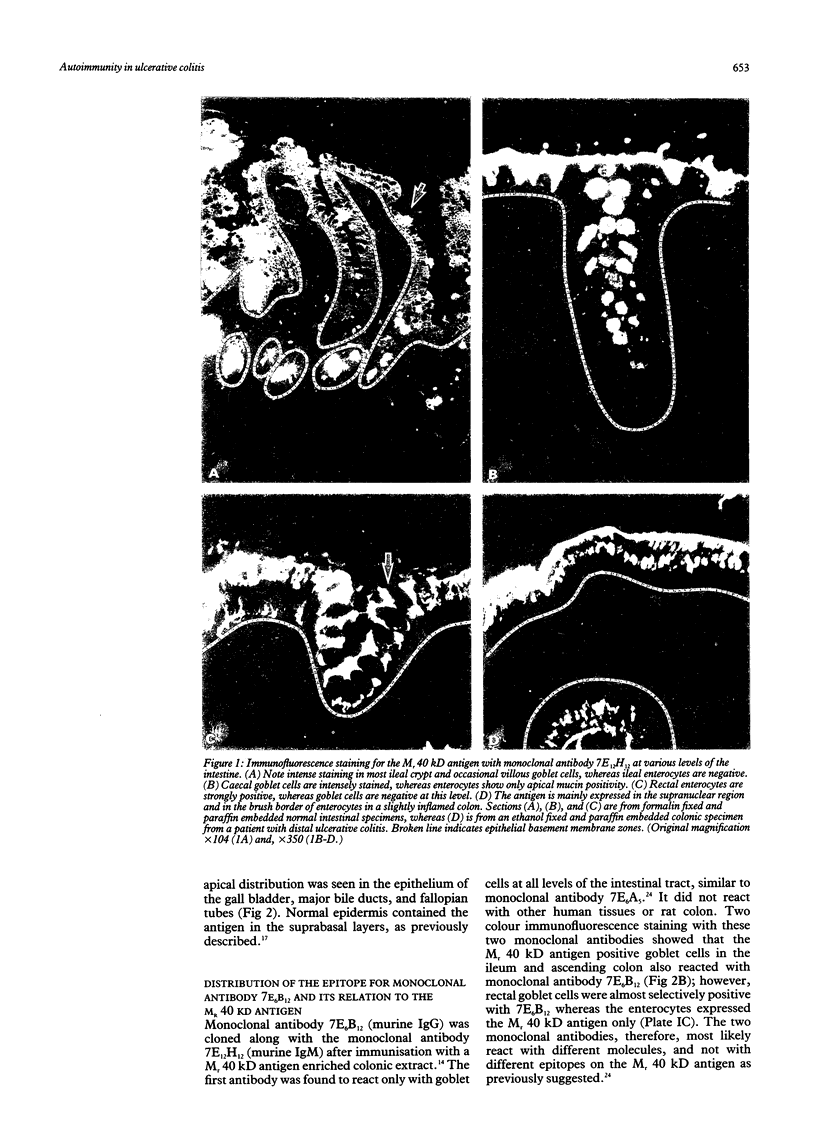

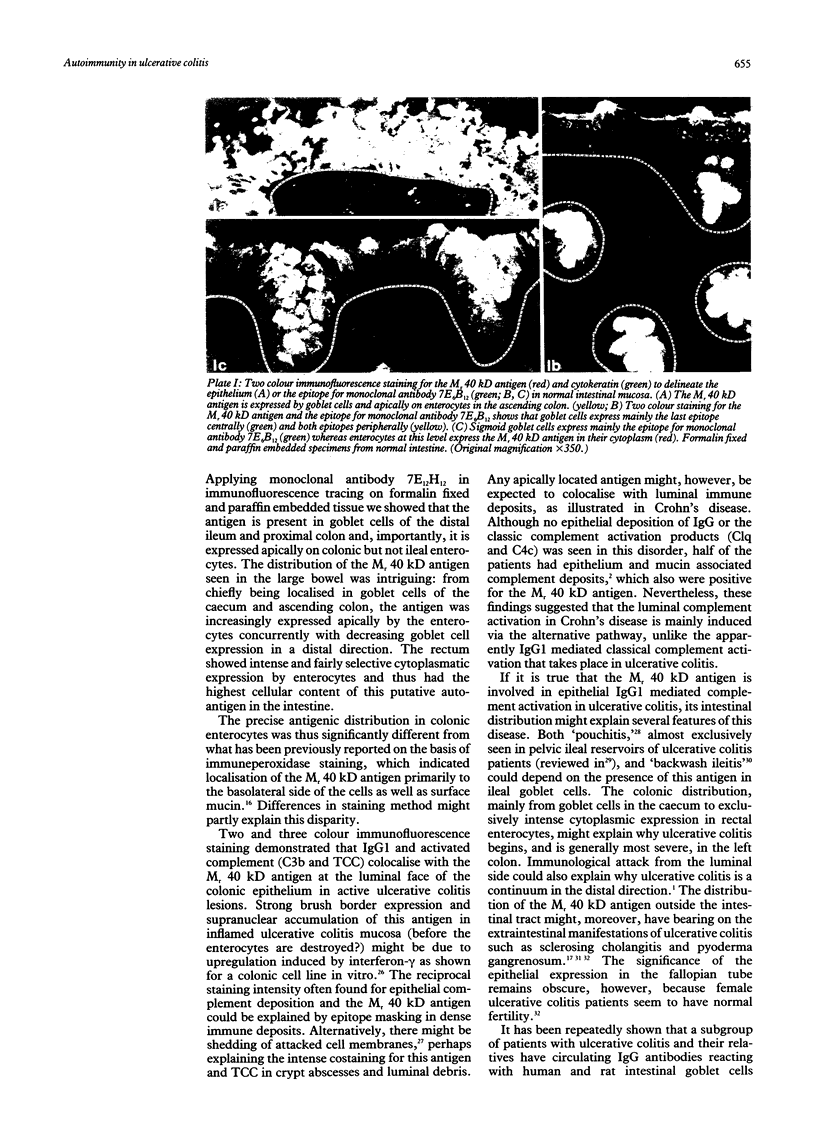

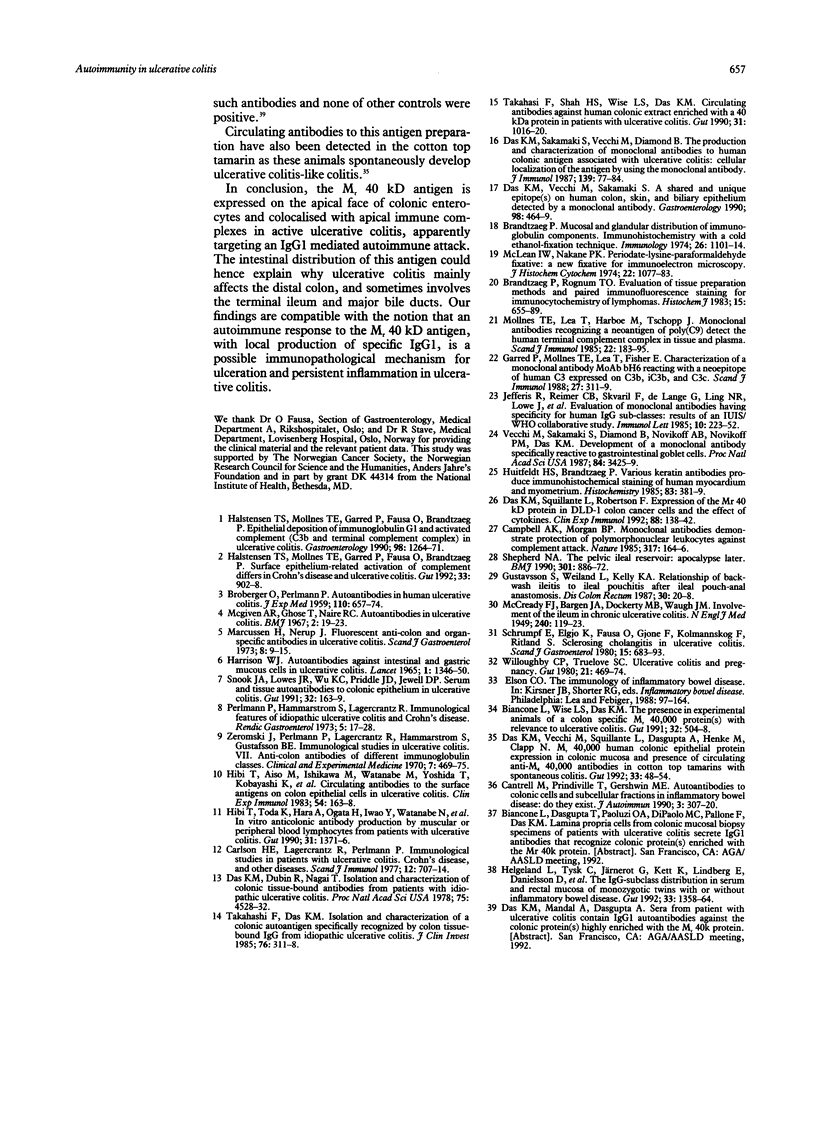
Images in this article
Selected References
These references are in PubMed. This may not be the complete list of references from this article.
- Biancone L., Wise L. S., Das K. M. The presence in experimental animals of a colon specific Mr 40,000 protein(s) with relevance to ulcerative colitis. Gut. 1991 May;32(5):504–508. doi: 10.1136/gut.32.5.504. [DOI] [PMC free article] [PubMed] [Google Scholar]
- Brandtzaeg P. Mucosal and glandular distribution of immunoglobulin components. Immunohistochemistry with a cold ethanol-fixation technique. Immunology. 1974 Jun;26(6):1101–1114. [PMC free article] [PubMed] [Google Scholar]
- Brandtzaeg P., Rognum T. O. Evaluation of tissue preparation methods and paired immunofluorescence staining for immunocytochemistry of lymphomas. Histochem J. 1983 Jul;15(7):655–689. doi: 10.1007/BF01002987. [DOI] [PubMed] [Google Scholar]
- Campbell A. K., Morgan B. P. Monoclonal antibodies demonstrate protection of polymorphonuclear leukocytes against complement attack. Nature. 1985 Sep 12;317(6033):164–166. doi: 10.1038/317164a0. [DOI] [PubMed] [Google Scholar]
- Cantrell M., Prindiville T., Gershwin M. E. Autoantibodies to colonic cells and subcellular fractions in inflammatory bowel disease: do they exist? J Autoimmun. 1990 Jun;3(3):307–320. doi: 10.1016/0896-8411(90)90149-m. [DOI] [PubMed] [Google Scholar]
- Carlsson H. E., Lagercrantz R., Perlmann P. Immunological studies in ulcerative colitis. VIII. Antibodies to colon antigen in patients with ulcerative colitis, Crohn's disease, and other diseases. Scand J Gastroenterol. 1977;12(6):707–714. doi: 10.3109/00365527709181708. [DOI] [PubMed] [Google Scholar]
- Das K. M., Dubin R., Nagai T. Isolation and characterization of colonic tissue-bound antibodies from patients with idiopathic ulcerative colitis. Proc Natl Acad Sci U S A. 1978 Sep;75(9):4528–4532. doi: 10.1073/pnas.75.9.4528. [DOI] [PMC free article] [PubMed] [Google Scholar]
- Das K. M., Sakamaki S., Vecchi M., Diamond B. The production and characterization of monoclonal antibodies to a human colonic antigen associated with ulcerative colitis: cellular localization of the antigen by using the monoclonal antibody. J Immunol. 1987 Jul 1;139(1):77–84. [PubMed] [Google Scholar]
- Das K. M., Squillante L., Robertson F. Expression of the 40 kD protein in DLD-1 colon cancer cells and the effect of cytokines. Clin Exp Immunol. 1992 Apr;88(1):138–142. doi: 10.1111/j.1365-2249.1992.tb03053.x. [DOI] [PMC free article] [PubMed] [Google Scholar]
- Das K. M., Vecchi M., Sakamaki S. A shared and unique epitope(s) on human colon, skin, and biliary epithelium detected by a monoclonal antibody. Gastroenterology. 1990 Feb;98(2):464–469. doi: 10.1016/0016-5085(90)90839-s. [DOI] [PubMed] [Google Scholar]
- Das K. M., Vecchi M., Squillante L., Dasgupta A., Henke M., Clapp N. Mr 40,000 human colonic epithelial protein expression in colonic mucosa and presence of circulating anti-Mr 40,000 antibodies in cotton top tamarins with spontaneous colitis. Gut. 1992 Jan;33(1):48–54. doi: 10.1136/gut.33.1.48. [DOI] [PMC free article] [PubMed] [Google Scholar]
- Frandsen P. J., Jarnum S., Malmstrøm J. Crohn's disease of the duodenum. Scand J Gastroenterol. 1980;15(6):683–688. doi: 10.3109/00365528009181515. [DOI] [PubMed] [Google Scholar]
- Fujiwara M., Watanabe H. Responsiveness of T cells to mutant major histocompatibility complex class I antigen. I. Obligatory dependence of proliferative response on the presence of stimulator type accessory cells. Scand J Immunol. 1988 Mar;27(3):311–318. doi: 10.1111/j.1365-3083.1988.tb02352.x. [DOI] [PubMed] [Google Scholar]
- Halstensen T. S., Mollnes T. E., Garred P., Fausa O., Brandtzaeg P. Epithelial deposition of immunoglobulin G1 and activated complement (C3b and terminal complement complex) in ulcerative colitis. Gastroenterology. 1990 May;98(5 Pt 1):1264–1271. doi: 10.1016/0016-5085(90)90343-y. [DOI] [PubMed] [Google Scholar]
- Halstensen T. S., Mollnes T. E., Garred P., Fausa O., Brandtzaeg P. Surface epithelium related activation of complement differs in Crohn's disease and ulcerative colitis. Gut. 1992 Jul;33(7):902–908. doi: 10.1136/gut.33.7.902. [DOI] [PMC free article] [PubMed] [Google Scholar]
- Helgeland L., Tysk C., Järnerot G., Kett K., Lindberg E., Danielsson D., Andersen S. N., Brandtzaeg P. IgG subclass distribution in serum and rectal mucosa of monozygotic twins with or without inflammatory bowel disease. Gut. 1992 Oct;33(10):1358–1364. doi: 10.1136/gut.33.10.1358. [DOI] [PMC free article] [PubMed] [Google Scholar]
- Hibi T., Aiso S., Ishikawa M., Watanabe M., Yoshida T., Kobayashi K., Asakura H., Tsuru S., Tsuchiya M. Circulating antibodies to the surface antigens on colon epithelial cells in ulcerative colitis. Clin Exp Immunol. 1983 Oct;54(1):163–168. [PMC free article] [PubMed] [Google Scholar]
- Hibi T., Ohara M., Toda K., Hara A., Ogata H., Iwao Y., Watanabe N., Watanabe M., Hamada Y., Kobayashi K. In vitro anticolon antibody production by mucosal or peripheral blood lymphocytes from patients with ulcerative colitis. Gut. 1990 Dec;31(12):1371–1376. doi: 10.1136/gut.31.12.1371. [DOI] [PMC free article] [PubMed] [Google Scholar]
- Huitfeldt H. S., Brandtzaeg P. Various keratin antibodies produce immunohistochemical staining of human myocardium and myometrium. Histochemistry. 1985;83(5):381–389. doi: 10.1007/BF00509196. [DOI] [PubMed] [Google Scholar]
- Jefferis R., Reimer C. B., Skvaril F., de Lange G., Ling N. R., Lowe J., Walker M. R., Phillips D. J., Aloisio C. H., Wells T. W. Evaluation of monoclonal antibodies having specificity for human IgG sub-classes: results of an IUIS/WHO collaborative study. Immunol Lett. 1985;10(3-4):223–252. doi: 10.1016/0165-2478(85)90082-3. [DOI] [PubMed] [Google Scholar]
- Marcussen H., Nerup J. Fluorescent anti-colon and organ-specific antibodies in ulcerative colitis. Scand J Gastroenterol. 1973;8(1):9–15. [PubMed] [Google Scholar]
- McLean I. W., Nakane P. K. Periodate-lysine-paraformaldehyde fixative. A new fixation for immunoelectron microscopy. J Histochem Cytochem. 1974 Dec;22(12):1077–1083. doi: 10.1177/22.12.1077. [DOI] [PubMed] [Google Scholar]
- Mollnes T. E., Lea T., Harboe M., Tschopp J. Monoclonal antibodies recognizing a neoantigen of poly(C9) detect the human terminal complement complex in tissue and plasma. Scand J Immunol. 1985 Aug;22(2):183–195. doi: 10.1111/j.1365-3083.1985.tb01870.x. [DOI] [PubMed] [Google Scholar]
- Shepherd N. A. The pelvic ileal reservoir: apocalypse later? BMJ. 1990 Oct 20;301(6757):886–887. doi: 10.1136/bmj.301.6757.886. [DOI] [PMC free article] [PubMed] [Google Scholar]
- Snook J. A., Lowes J. R., Wu K. C., Priddle J. D., Jewell D. P. Serum and tissue autoantibodies to colonic epithelium in ulcerative colitis. Gut. 1991 Feb;32(2):163–166. doi: 10.1136/gut.32.2.163. [DOI] [PMC free article] [PubMed] [Google Scholar]
- Takahashi F., Das K. M. Isolation and characterization of a colonic autoantigen specifically recognized by colon tissue-bound immunoglobulin G from idiopathic ulcerative colitis. J Clin Invest. 1985 Jul;76(1):311–318. doi: 10.1172/JCI111963. [DOI] [PMC free article] [PubMed] [Google Scholar]
- Takahasi F., Shah H. S., Wise L. S., Das K. M. Circulating antibodies against human colonic extract enriched with a 40 kDa protein in patients with ulcerative colitis. Gut. 1990 Sep;31(9):1016–1020. doi: 10.1136/gut.31.9.1016. [DOI] [PMC free article] [PubMed] [Google Scholar]
- Vecchi M., Sakamaki S., Diamond B., Novikoff A. B., Novikoff P. M., Das K. M. Development of a monoclonal antibody specifically reactive to gastrointestinal goblet cells. Proc Natl Acad Sci U S A. 1987 May;84(10):3425–3429. doi: 10.1073/pnas.84.10.3425. [DOI] [PMC free article] [PubMed] [Google Scholar]
- Willoughby C. P., Truelove S. C. Ulcerative colitis and pregnancy. Gut. 1980 Jun;21(6):469–474. doi: 10.1136/gut.21.6.469. [DOI] [PMC free article] [PubMed] [Google Scholar]
- Zeromski J., Perlmann P., Lagercrantz R., Hammarström S., Gustafsson B. E. Immunological studies in ulcerative colitis. VII. Anti-colon antibodies of different immunoglobulin classes. Clin Exp Immunol. 1970 Oct;7(4):469–475. [PMC free article] [PubMed] [Google Scholar]



